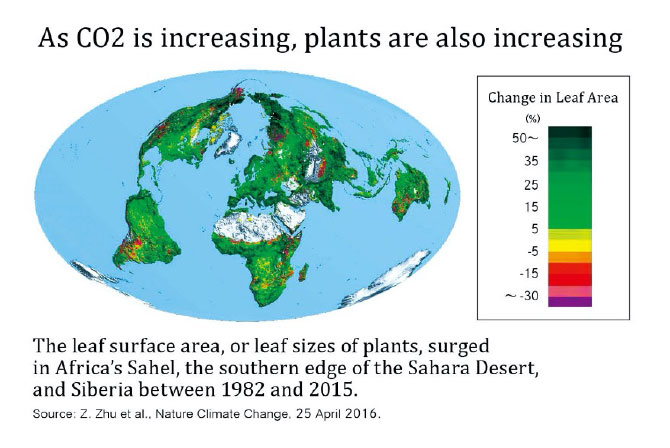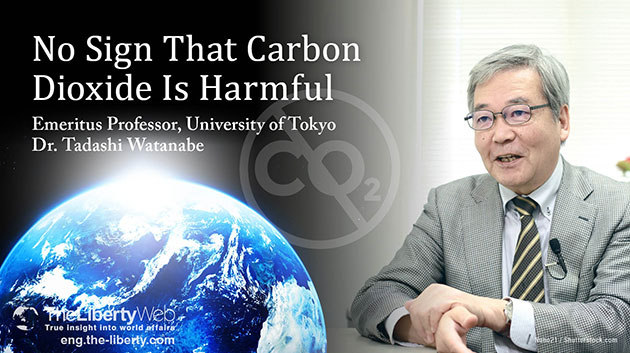No Sign That Carbon Dioxide Is Harmful
Emeritus Professor, University of Tokyo
Dr. Tadashi Watanabe
Dr. Watanabe was born in Tottori prefecture, Japan, in 1948. He graduated from the University of Tokyo Graduate School with a doctorate in engineering. Before holding his current title as Professor Emeritus, he had been a professor at the University of Tokyo since 1992 under the Institute of Industrial Science and retired from the University in 2012. He has written and translated approximately 180 works including “‘Chikyu Ondanka’ no Futsugo na Shinjitsu” (Note: This book is only published in Japanese, but directly translates to “The Inconvenient Truth Behind ‘Global Warming'”).
In the New Year’s television special, “Global Warming is Getting Out of Control: The Challenge of Decarbonization,” (Note: directly translated from the official Japanese title) Japan’s public broadcaster NHK introduced that “Earth’s temperature will rise by 4.5 degrees in 2100, and the future of this planet is in jeopardy.” The program mentioned that “snow may never fall due to global warming,” but there was a rare heavy snowfall around the time of the airing date which was unfortunate timing for the program.
The Liberty spoke with Dr. Tadashi Watanabe, who specializes in electrochemistry and is an expert on environmental research, about the problems of global warming theory which Japan’s NHK place reliance on.
— NHK’s program said that Earth’s temperature will rise by 4.5 degrees Celsius (about 40 degrees Fahrenheit) in 2100 and our future is at risk.
Dr. Watanabe: The Earth’s temperature is determined by a combination of several factors. ‘4.5 degrees Celsius’ is the result of a computer simulation, but it is just the result of one program written by researchers. If you average the results of various simulations from the end of the 20th century, the temperature from 1975 until today should’ve been up by one degree. In reality, it hasn’t even gone up by a half of that number.
There are natural fluctuations in the temperature of Earth. There was a cold period called the Little Ice Age that continued for about 500 years until the end of the Edo period (between 1603 and 1867 in the history of Japan). Cold weather continued during the Edo period, and there is also documentation that the Thames River in London froze during the wintertime.
The average temperature of Earth is rising almost independently of man-made carbon dioxide, but since this increase is less than 0.1 degrees Celsius (32.18 degrees Fahrenheit) in 10 years, you can’t even feel it.
— The program also claimed that glaciers are melting due to global warming, causing our sea levels to rise.
Dr. Watanabe: During a period in which the temperature is rising, the sea level will rise because water expands thermally. But eventually, the sea level will start to fall due to cooling. We also learned at the end of the 20th century that the sea surface temperature naturally fluctuates in various cycles.
Glaciers Collapse Because Cooling Caused the Growth of Ice
Dr. Watanabe: When the water temperature rises, some of the dissolved gas will disperse into the atmosphere. The CO2 concentration in the atmosphere, which has increased linearly over the past 30 years, seems to be the result of a slowly rising temperature, that is, a natural fluctuation.
It is said that the Artic sea ice is decreasing, but we’re just coming across a period in which the sea temperature rises every 60 years. TV shows often show scenes of glaciers collapsing, but in fact, the more ice there is, the greater the force of the collapse. Then, the cause becomes global cooling [laughter]. As a matter of fact, in about 80 years of observation, atmospheric temperature and sea temperature near the South Pole have been flat or slightly declining.
Thus, the temperature, CO2 concentration and sea level are only gradually going through natural fluctuations. Human activities contribute very little to the rise in temperature. Moreover, Japan emits only about 3% of the world’s total CO2, so it makes almost no sense to put in ‘decarbonization’ efforts.
The Japanese government plans on spending more than 100 trillion yen (about 0.93 trillion dollars) by 2030 on global warming efforts, but if they have that kind of money, they should spend it on disaster prevention, medical care or welfare.
Expensive solar and wind power generations are severely damaging to the environment, and they cannot be used as base power sources because they are too unstable. I haven’t seen any Japanese mainstream media reporting, but in February, icy weather froze windmills in Texas, creating a great power outage.
Today’s Plants Are CO2-Deficient
— There is also a theory that a rise in CO2 levels causes an increase in greens.
Dr. Watanabe: Studies of plant fossils have shown that when plants flourished on Earth a few hundred million years ago, CO2 levels at the time were about five times higher than they are today. In other words, today’s plants are in a ‘CO2-deficient state.’ Therefore, within greenhouse cultivation, they are raising internal CO2 concentration levels by several times to activate photosynthesis.
CO2 concentration is now 415 ppm, but the world’s greenery has increased by about 10% in the last 30 years. The Sahel region in Africa is remarkable (as the diagram below indicates). Any food is either a direct or indirect product of photosynthesis, so the increase in atmospheric CO2 levels contribute to the reduction of a starving population.

The Lie Behind ‘Permafrost Melts and Global Warming Becomes Out of Control’
— The NHK program also featured a claim that when the temperature rises, Siberia’s permafrost melts and produces methane gas. They argue that this methane gas has a greenhouse effect 25 times that of CO2 so global warming becomes out of control.
Dr. Watanabe: That’s not for the entire Siberia, but a local phenomenon. The greenhouse effect of methane may be true, but some temperature rise is good news for crops to grow. If you consider the cultivation of colder regions, the pros should be overwhelmingly larger.
There is also talk that rising atmospheric CO2 levels kill coral reefs, but even in areas with submarine volcanoes, coral reefs are growing well despite the waters in which CO2 from volcanoes are saturated.
CO2 is a grace, and trying to reduce that is not what human beings should do.
We were talking about global cooling until the 1980s and since the 1990s the dialogue shifted to global warming. It shows how much we have yet to know about the Earth, so it’s quite easy to make up scare stories. These scare stories become the source of research expenditures and profits. Global warming has become the source of income. We can’t keep up with this grand fantasy anymore.
Given that NHK sells themselves as a public broadcaster, they should report not only scare stories from the United Nations, but also provide these arguments.
Column
The Lie Behind Not Being Able to Consume Inshore Fish
NHK’s television special claimed, “there will be less and less inshore fish by 2100, and we will not be able to eat sushi,” featuring that global warming will have a major impact on marine resources. Certainly, the Fisheries Research Agency (currently the Fisheries Research and Education Agency) announced in 2005 that due to the effect of global warming, Japan’s horse mackerel, bream or flatfish hauls may decline between 30 and 70 percent in the next 100 years.
At the same time, however, the Agency also predicted that hauls of red sea bream and horse mackerel in the northern part of Japanese main island as well as oysters in Hokkaido (northernmost prefecture) will increase; they also predicted that it would become possible to catch southern fish in western Japan. The takeaway is that Japanese people may need to change their diet, so NHK’s claim that Japanese people will not have any sushi by 2100 is an exaggeration.



















